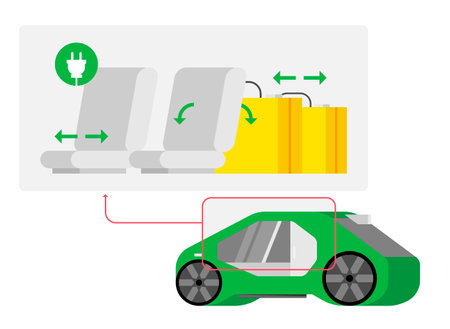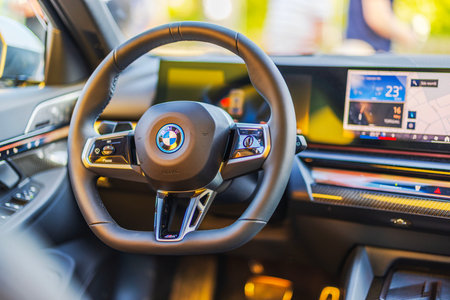1. Introduction to Autonomous Driving
Autonomous driving has transformed from a futuristic concept into a rapidly evolving reality. Over the years, advancements in technology have paved the way for self-driving vehicles that promise to enhance safety, convenience, and efficiency on the roads. This article explores the evolution of autonomous driving, its significance, and how vehicles have progressed from basic cruise control to full automation.
Overview of Self-Driving Technology
Self-driving technology relies on a combination of sensors, artificial intelligence (AI), and advanced computing systems to navigate roads without human inputs. These vehicles utilize cameras, radar, lidar, and GPS to detect their surroundings and make real-time driving decisions.
Significance of Autonomous Vehicles
Autonomous vehicles have the potential to revolutionize transportation in several ways:
- Safety: By reducing human errors, self-driving cars can lower accident rates.
- Convenience: Automated driving allows passengers to focus on other tasks instead of driving.
- Efficiency: AI-powered driving can optimize traffic flow and reduce congestion.
The Evolution of Autonomous Vehicles
The journey toward full automation has progressed through various stages. Here’s a breakdown of the different levels of autonomous driving:
| Level | Description | Example |
|---|---|---|
| Level 0 | No automation; driver controls everything. | Traditional vehicles |
| Level 1 | Basic driver assistance, such as adaptive cruise control. | Early cruise control systems |
| Level 2 | Partial automation, with control over speed and steering. | Teslas Autopilot |
| Level 3 | Conditional automation, where the car handles driving in certain conditions. | Some Audi models with Traffic Jam Pilot |
| Level 4 | High automation, allowing full control, but only in specific areas. | Waymos autonomous taxis |
| Level 5 | Full automation, no human intervention required. | Future autonomous vehicles |
Looking Ahead
With continuous technological advancements, self-driving technology is becoming more sophisticated. The development of AI, improvements in sensor technology, and regulatory support will play a crucial role in making fully autonomous vehicles a common sight on our roads in the future.
2. From Cruise Control to Advanced Driver Assistance Systems (ADAS)
The journey toward autonomous driving began with early automation technologies that aimed to enhance driving convenience and safety. These foundational systems laid the groundwork for more advanced driver assistance technologies that we see today.
Early Automation: Cruise Control
Cruise control was one of the first steps toward driving automation. Introduced in the 1950s, this system allowed drivers to maintain a steady speed without keeping their foot on the gas pedal. Early versions were simple, requiring manual adjustments to change speed or deactivate the system.
Adaptive Cruise Control (ACC): Smarter Speed Management
As technology advanced, cruise control evolved into Adaptive Cruise Control (ACC). This system not only maintained a set speed but also adjusted it based on the distance from the vehicle ahead. Using radar and sensors, ACC improves driving comfort and safety by reducing the need for constant speed adjustments in traffic.
Key Differences Between Cruise Control and Adaptive Cruise Control
| Feature | Cruise Control | Adaptive Cruise Control (ACC) |
|---|---|---|
| Speed Maintenance | Keeps a constant speed | Adjusts speed based on traffic conditions |
| Braking | Manual braking required | Automatically slows down if a vehicle is detected ahead |
| Sensors | No sensors required | Uses radar and cameras to monitor surroundings |
Lane-Keeping Assist: Staying in the Lane
Another significant step in automation is lane-keeping assist (LKA). This system helps drivers stay within their lane by making small steering adjustments when unintentional drifting is detected. Some versions offer only warnings, while advanced systems provide mild steering corrections.
How Lane-Keeping Assist Works
- Uses cameras to detect lane markings on the road.
- Alerts the driver if the vehicle drifts out of the lane without signaling.
- Applies minor steering input to guide the car back to the center of the lane.
The Building Blocks of Autonomous Driving
These early automation technologies—cruise control, adaptive cruise control, and lane-keeping assist—represent the foundation of autonomous driving. By reducing the drivers workload and improving safety, they have paved the way for more advanced driver assistance systems and, eventually, full automation.

3. The Role of AI and Sensors in Autonomous Vehicles
Autonomous driving relies on a combination of artificial intelligence (AI) and advanced sensor technologies to navigate roads, detect obstacles, and make real-time driving decisions. AI serves as the brain that processes vast amounts of data, while sensors such as LiDAR, radar, and cameras act as the vehicle’s eyes and ears.
How AI Powers Self-Driving Systems
Artificial intelligence enables self-driving systems to process data from multiple sensors, recognize objects, and predict the behavior of other road users. Machine learning algorithms allow vehicles to improve their driving capabilities over time, while neural networks help identify patterns in real-world traffic scenarios.
Key Functions of AI in Autonomous Vehicles
| Function | Description |
|---|---|
| Object Detection | Identifies vehicles, pedestrians, traffic signs, and road markings. |
| Path Planning | Determines the safest and most efficient route. |
| Decision Making | Analyzes real-time data to respond to changing traffic conditions. |
| Predictive Modeling | Anticipates the movements of other vehicles and pedestrians. |
The Role of LiDAR in Autonomous Vehicles
LiDAR (Light Detection and Ranging) is a key sensor technology that uses laser pulses to create 3D maps of the surroundings. It helps vehicles detect objects, measure distances, and navigate in various lighting conditions.
Advantages of LiDAR
- Provides accurate 3D mapping for precise navigation.
- Works well in low-light and nighttime conditions.
- Detects small objects that may be missed by other sensors.
Radar: Enhancing Object Detection
Radar (Radio Detection and Ranging) uses radio waves to detect objects and measure their speed and distance. It is particularly useful in adverse weather conditions, such as fog or heavy rain, where cameras and LiDAR may struggle.
Benefits of Radar
- Works in all weather conditions, including rain and fog.
- Tracks the speed and movement of objects in real-time.
- Detects vehicles and obstacles beyond the range of cameras.
Cameras: Providing Visual Perception
Cameras play a crucial role in autonomous driving by capturing real-world images for lane detection, traffic sign recognition, and object identification. Paired with AI, cameras enable vehicles to interpret road conditions and make safe driving decisions.
Types of Cameras in Autonomous Vehicles
| Type | Function |
|---|---|
| Monocular Cameras | Used for basic object recognition and lane detection. |
| Stereo Cameras | Provide depth perception for better distance measurement. |
| Infrared Cameras | Enhance visibility in low-light or nighttime conditions. |
3. Conclusion
AI and sensor technologies work together to enable autonomous vehicles to perceive their surroundings, make intelligent driving decisions, and ensure safety. By combining the strengths of LiDAR, radar, and cameras, self-driving systems continue to evolve toward full automation.
4. Regulatory and Safety Challenges
As autonomous driving technology continues to develop, regulations and safety concerns play a critical role in determining how and when these vehicles will become a common sight on the roads. Governments and industry leaders face challenges in creating legal frameworks, ensuring safety, and overcoming barriers to widespread adoption.
Legal Frameworks
One of the biggest roadblocks for autonomous vehicles is the lack of consistent regulations. Different countries and even states within the U.S. have varying policies governing self-driving cars, making it difficult for automakers to create universal solutions.
Current Regulatory Landscape
| Region | Regulatory Approach |
|---|---|
| United States | Varies by state; some states allow extensive testing, while others have stricter requirements. |
| European Union | Developing uniform regulations; current rules allow limited autonomous features. |
| China | Government-led initiatives encourage self-driving technology, but strict regulations remain. |
Safety Concerns
While autonomous technology has the potential to reduce accidents caused by human error, safety remains a major concern. Issues such as sensor limitations, unpredictable human drivers, and cybersecurity risks need to be addressed.
Key Safety Challenges
- Sensor Accuracy: Weather conditions and unpredictable obstacles can interfere with a vehicle’s sensors.
- Human Interaction: Autonomous cars must effectively anticipate and react to human drivers and pedestrians.
- Cybersecurity Risks: Hackers could target self-driving systems, posing potential threats to passengers and pedestrians.
Barriers to Widespread Adoption
Several factors are slowing down the mass adoption of autonomous vehicles. Beyond regulations and safety, public perception and infrastructure present additional obstacles.
Main Barriers
- Public Trust: Many people remain skeptical about fully trusting a car to drive itself.
- Infrastructure: Roads and traffic systems are not yet optimized for autonomous vehicle navigation.
- High Costs: Advanced autonomous technology remains expensive, limiting affordability for the general public.
Overcoming these challenges will require collaboration between governments, car manufacturers, and technology developers. As policies evolve and technology improves, self-driving cars may become safer and more accessible for everyday use.
5. Five, The Future of Full Automation
Potential Advancements in Autonomous Driving
Autonomous driving technology is advancing rapidly, with new breakthroughs in artificial intelligence (AI), sensor technology, and data processing. These advancements are pushing self-driving vehicles closer to achieving full automation, where no human intervention is required.
Key Technological Advancements
| Technology | Impact on Autonomous Vehicles |
|---|---|
| AI & Machine Learning | Enhances decision-making capabilities, improving safety and efficiency. |
| Lidar & Radar Systems | Provides better object detection and environmental mapping. |
| V2X Communication | Enables vehicles to communicate with each other and infrastructure to avoid collisions. |
| Improved Battery Technology | Extends electric vehicle range, making autonomous fleets more practical. |
The Transition to Level 5 Autonomy
Reaching Level 5 autonomy, where vehicles operate without any human input, is a complex challenge. Companies must overcome regulatory hurdles, safety concerns, and technological limitations before achieving mass adoption.
Main Challenges in Achieving Level 5 Autonomy
- Regulations: Governments must establish safety standards and liability laws before self-driving cars can operate without restrictions.
- Public Trust: Users need to trust autonomous driving systems to feel safe without a steering wheel or manual controls.
- Infrastructure Readiness: Cities will need smart traffic systems and vehicle-to-infrastructure (V2I) support.
- Extreme Weather Adaptation: Autonomous vehicles must handle snow, fog, and other challenging conditions safely.
The Impact on Transportation and Society
Once fully autonomous technology is widely implemented, it will change how people travel, how goods are transported, and how cities are designed.
Expected Changes in Transportation
| Category | Future Impact |
|---|---|
| Ride-Sharing Services | Self-driving taxis will make transportation more affordable and accessible. |
| Freight & Logistics | Autonomous trucks will improve efficiency and reduce delivery costs. |
| Traffic Safety | Fewer accidents due to AI-driven decision-making and vehicle-to-vehicle communication. |
| Urban Infrastructure | Less need for parking spaces, allowing for more green spaces and pedestrian pathways. |
How Society May Change
In a world with fully autonomous vehicles, personal car ownership may decline as shared self-driving fleets become the norm. Commutes may become more productive, as passengers can work or relax during their trips. Additionally, accessibility for the elderly and disabled could improve, giving them greater freedom to travel without relying on others.


